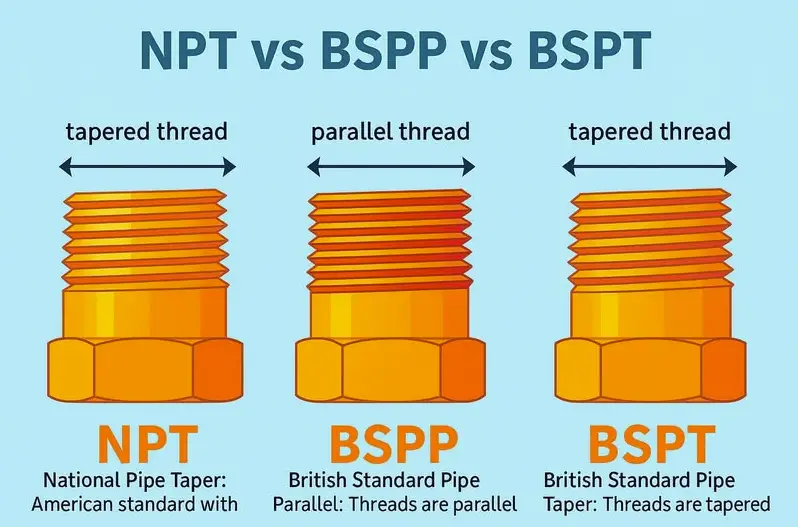
Threaded fittings are crucial in plumbing, hydraulic systems, and gas applications. The three most common types are NPT (National Pipe Thread), BSPP (British Standard Pipe Parallel), and BSPT (British Standard Pipe Tapered). Here’s how they differ:
1. NPT (National Pipe Tapered)
-
Origin: U.S. standard (ANSI/ASME B1.20.1)
-
Thread Type: Tapered (Diameter decreases along the thread)
-
Angle: 60° thread angle
-
Sealing Method: Requires thread sealant (Teflon tape or pipe dope) for a leak-proof seal
-
Common Uses:
-
Plumbing (North America)
-
Oil & gas industries
-
Compressed air systems
-
-
Compatibility: Not interchangeable with BSP threads
2. BSPP (British Standard Pipe Parallel) – G Thread
-
Origin: British/European standard (ISO 228)
-
Thread Type: Straight/Parallel (Constant diameter)
-
Angle: 55° thread angle
-
Sealing Method:
-
Uses a washer or O-ring (not the threads) for sealing
-
Often found in hydraulic fittings
-
-
Common Uses:
-
Hydraulic systems (Europe/Asia)
-
Water and gas connections (with sealing washer)
-
-
Compatibility:
-
Can mate with BSPT (tapered) female threads but requires sealant
-
Not compatible with NPT
-
3. BSPT (British Standard Pipe Tapered) – R Thread
-
Origin: British/European standard (ISO 7)
-
Thread Type: Tapered (Like NPT but different angle)
-
Angle: 55° thread angle
-
Sealing Method:
-
Relies on thread interference + sealant (similar to NPT)
-
-
Common Uses:
-
High-pressure hydraulic systems
-
Gas pipelines (Europe/Asia)
-
-
Compatibility:
-
Can fit into BSPP (parallel) female threads with sealant
-
Not compatible with NPT (different taper & angle)
-
Key Differences Summary
| Feature | NPT (USA) | BSPP (Parallel) | BSPT (Tapered) |
|---|---|---|---|
| Thread Type | Tapered | Parallel | Tapered |
| Thread Angle | 60° | 55° | 55° |
| Sealing Method | Thread sealant (Teflon) | Washer/O-ring | Thread sealant |
| Common Use | Plumbing, oil/gas | Hydraulics, water | High-pressure gas/hydraulics |
| Compatibility | Not compatible with BSP | Fits BSPT (with sealant) | Fits BSPP (with sealant) |
Can NPT and BSP Threads Be Used Together?
❌ No – They have different thread angles (60° vs. 55°) and tapers, leading to leaks or thread damage.
✅ Solution: Use an adapter (e.g., NPT-to-BSPT) if cross-compatibility is needed.
